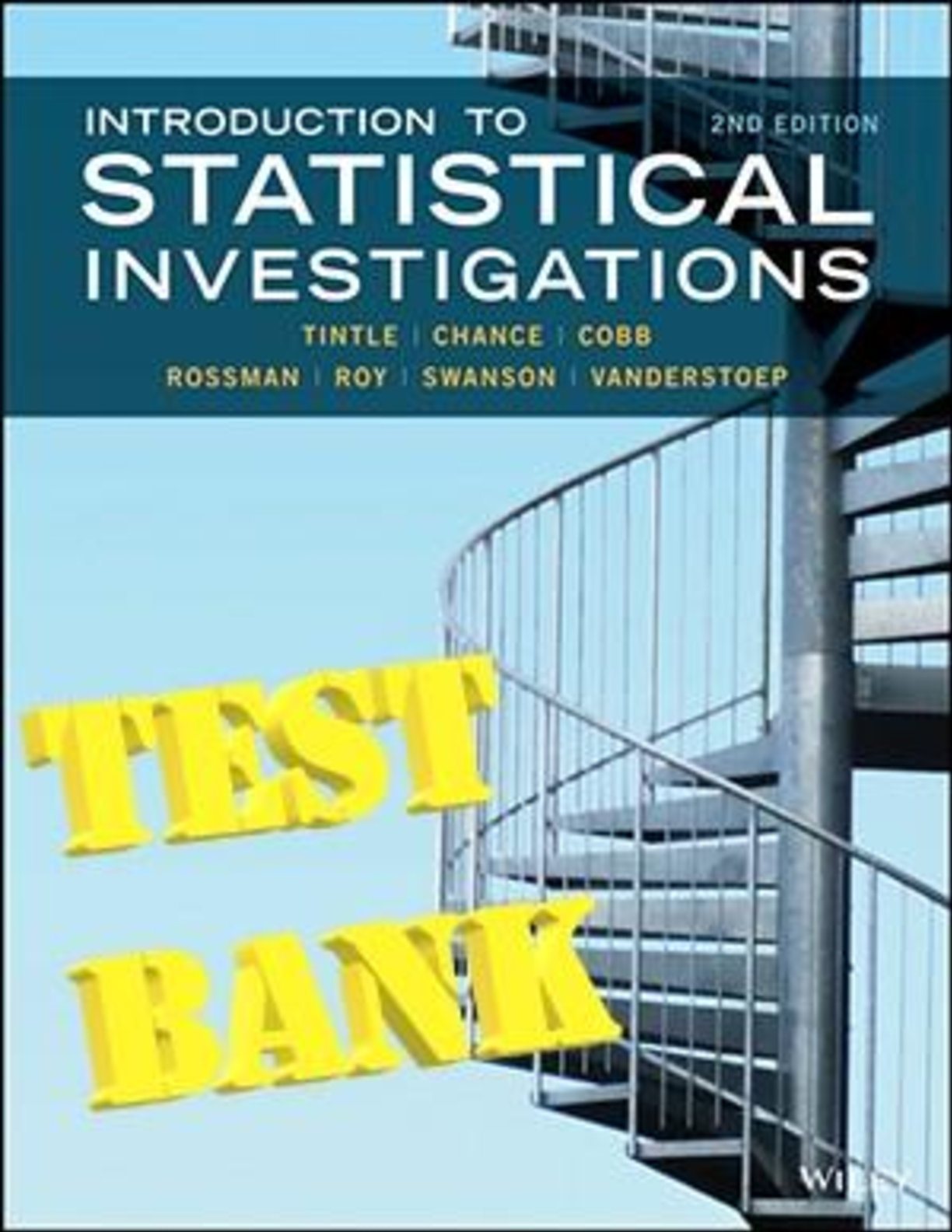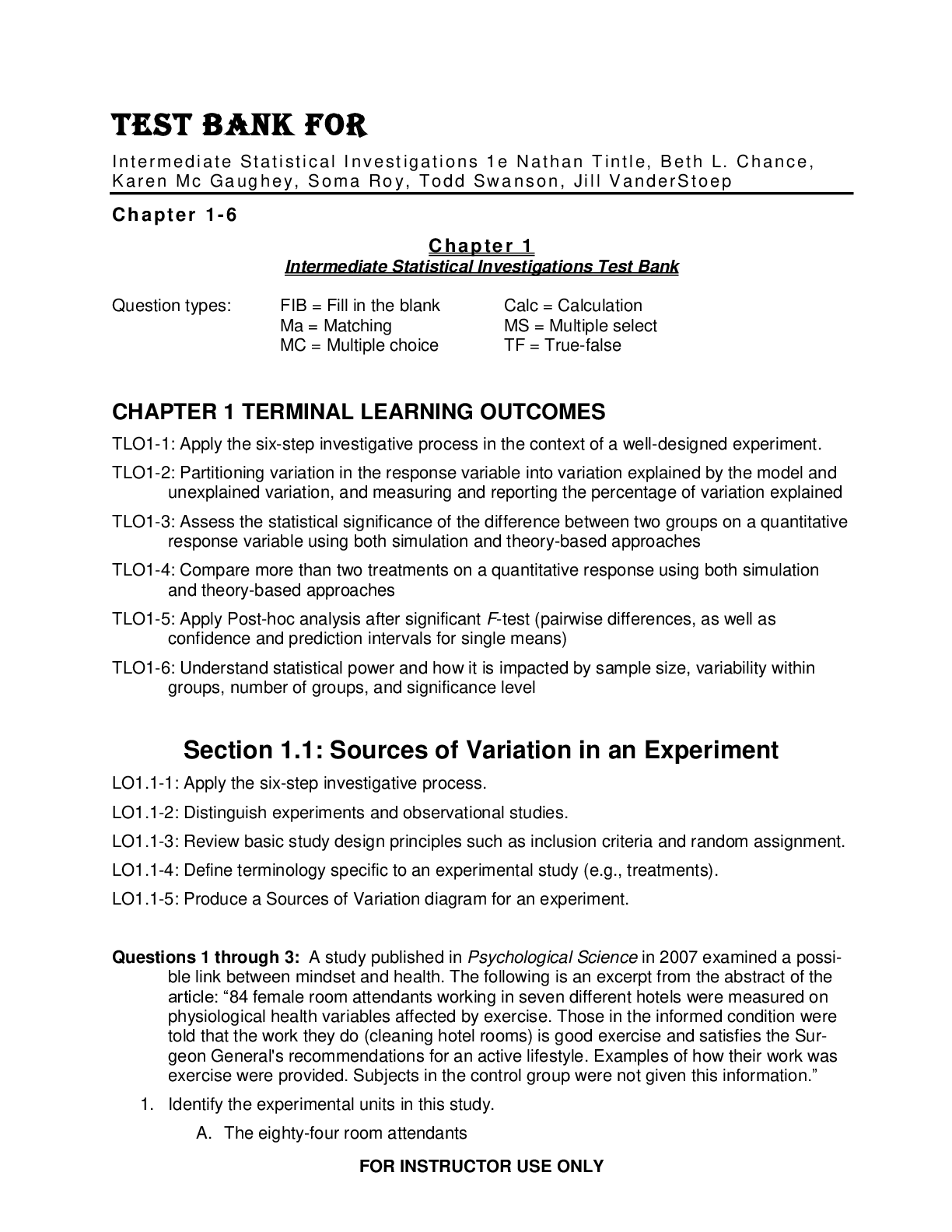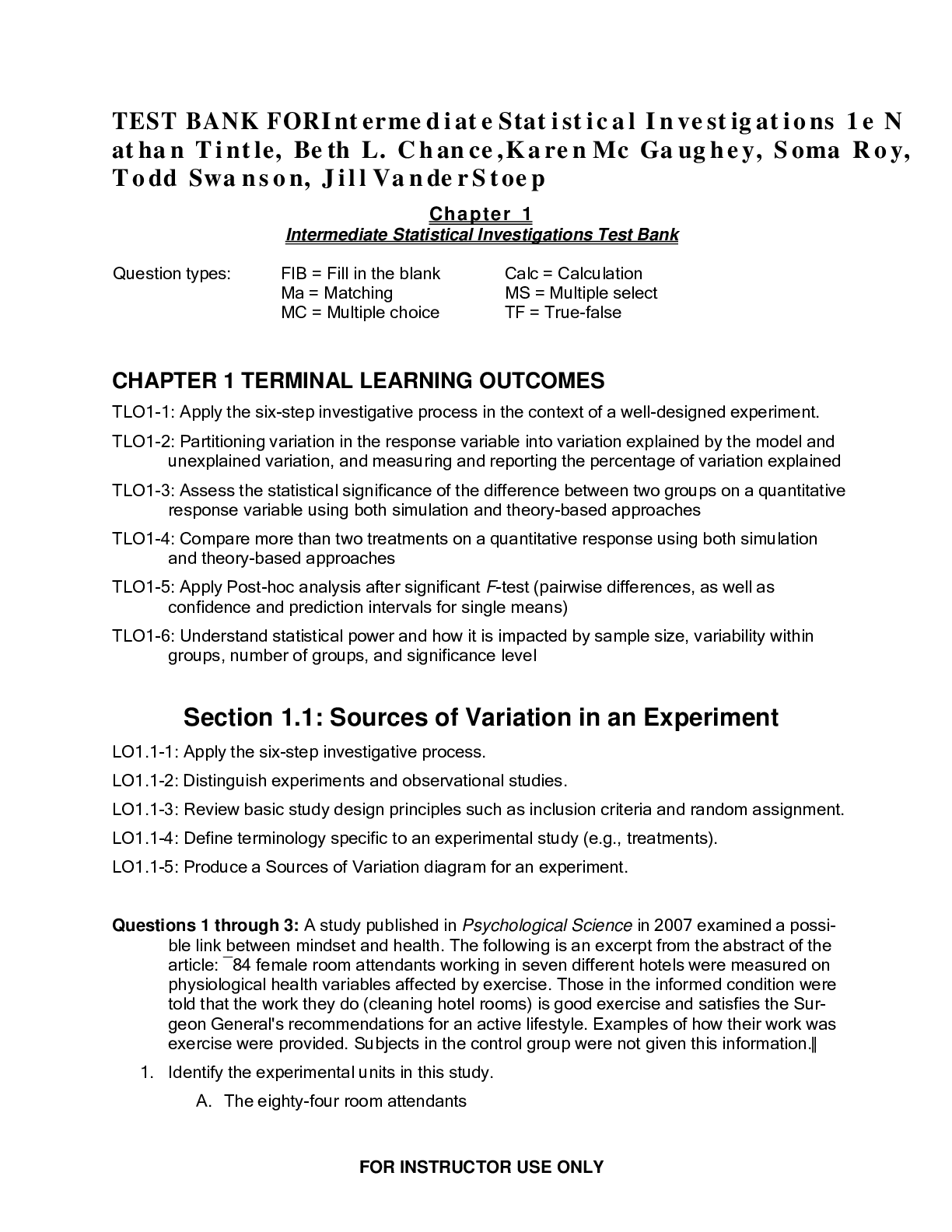Statistics > TEST BANKS > Test Bank For Intermediate Statistical Investigations 1th Edition by Nathan Tintle, Beth L. Chance, (All)
Test Bank For Intermediate Statistical Investigations 1th Edition by Nathan Tintle, Beth L. Chance, Karen McGaughey, Soma Roy, Todd Swanson, Jill VanderStoep
Document Content and Description Below
Test Bank For Intermediate Statistical Investigations 1th Edition by Nathan Tintle, Beth L. Chance, Karen McGaughey, Soma Roy, Todd Swanson, Jill VanderStoep-1. Identify the experimental units in this... study. A. The eighty-four room attendants FOR INSTRUCTOR USE ONLY 1-2 B. The seven different hotels C. The physiological health variables D. The two groups (informed and control) Ans: A; LO: 1.1-4; Difficulty: Easy; Type: MC 2. The researchers chose to include room attendants from seven different hotels (as opposed to using stricter inclusion criteria that would limit the study to room attendants at one particular hotel). Describe the consequences of this decision. Using broader inclusion criteria may (increase/decrease) the amount of variation in the observed health outcomes. However, this decision also (supports/limits) generalizability to a larger population of room attendants. Ans: increase, supports; LO: 1.1-3; Difficulty: Medium; Type: FIB 3. Room attendants were randomly assigned to either the informed condition or the control group. What is the most important reason for the random assignment? A. Random assignment ensures that the study is double-blind. B. Random assignment reduces the impact of outliers. C. Random assignment creates two groups of room attendants that are as similar as possible, which supports cause-and-effect conclusions. D. Random assignment makes it possible to generalize the results to the population. Ans: C; LO: 1.1-3; Difficulty: Medium; Type: MC Questions 4 through 6: An online retailer is using an experiment to decide whether to modify their website. When visitors type in the web address or click a link to the site, they are randomly re-directed to one of two versions of the website: the version that has been in use for the last year (version A) or an updated version (version B). The retailer’s goal is to maximize the amount of time (in minutes) visitors stay on the site. 4. Identify the experimental units and variables. Note: One of the answer choices will not be used. Experimental units: A. Version of the website (A and B) Explanatory variable: B: Online retailers Response variable: C: Visitors to the website D: Time spent on the website (in minutes) Ans: Experimental units: C, Explanatory variable: A, Response variable: D; LO: 1.1-4; Difficulty: Easy; Type: Ma 5. Consider two possible models for analyzing time spent on this retailer’s website. Single-mean model: A. Predicted timespent onsite12.33,SEof residuals 4.64 Separate-means model: 1-3 FOR INSTRUCTOR USE ONLY B. Predicted timespent on site 9.9 forVersion A , SEof residuals 3.98 14.7 forVersion B Does the version of the website appear to explain any of the variation in time spent on the site? Note: If more than one of these justifications is appropriate, select multiple answers. A. Yes, because the mean time spent on the site is higher for Version B than for Version A. B. Yes, because the SE of the residuals is smaller for the separate-means model than for the single-mean model. C. No, because the mean time spent on the site is not the same for Version A and for Version B. D. No, because the SE of the residuals is smaller for the separate-means model than for the single-mean model. Ans: A, B; LO: 1.1-1; Difficulty: Medium; Type: MS 6. The researcher decides that the difference between Version A and Version B in this study is meaningful. Is it reasonable to generalize these results to all customers of this retailer? A. Yes, because visitors to the website were randomly assigned to either Version A or Version B. B. Yes, because the study’s inclusion criteria would exclude potential subjects who are not customers. C. It depends whether visitors to the website knew about the research question being investigated. The study may not be double-blind. D. It depends who visited the website during the study period. The sample may not be representative. Ans: D; LO: 1.1-1; Difficulty: Medium; Type: MC Questions 7 through 8: Researchers at a university were interested in the effectiveness of a calculus workshop program for students who fail Calculus I and need to retake the course. As part of the study, students who were retaking Calculus I were allowed to enroll in a calculus workshop at their own discretion. At the end of the grading term, all students (even those with different instructors) took the same final exam. The researchers then compared the scores for those who enrolled in the workshop while re-taking calculus to those who re-took calculus without enrolling in the workshop. 7. Is this an experiment? Justify your answer. A. Yes, this is an experiment, because there was a treatment group who enrolled in the calculus workshop and a control group that did not. B. Yes, this is an experiment, because the study was double-blind (as long as the calculus teachers did not know which students enrolled in the workshop). C. No, this is an observational study, because it does not take place in a laboratory or other tightly controlled research environment. D. No, this is an observational study, because the choice of whether to participate in the workshop was made by the students not the researchers. [Show More]
Last updated: 5 months ago
Preview 5 out of 142 pages

Loading document previews ...
Buy this document to get the full access instantly
Instant Download Access after purchase
Buy NowInstant download
We Accept:

Reviews( 0 )
$13.50
Can't find what you want? Try our AI powered Search
Document information
Connected school, study & course
About the document
Uploaded On
Jan 29, 2025
Number of pages
142
Written in
Additional information
This document has been written for:
Uploaded
Jan 29, 2025
Downloads
0
Views
14

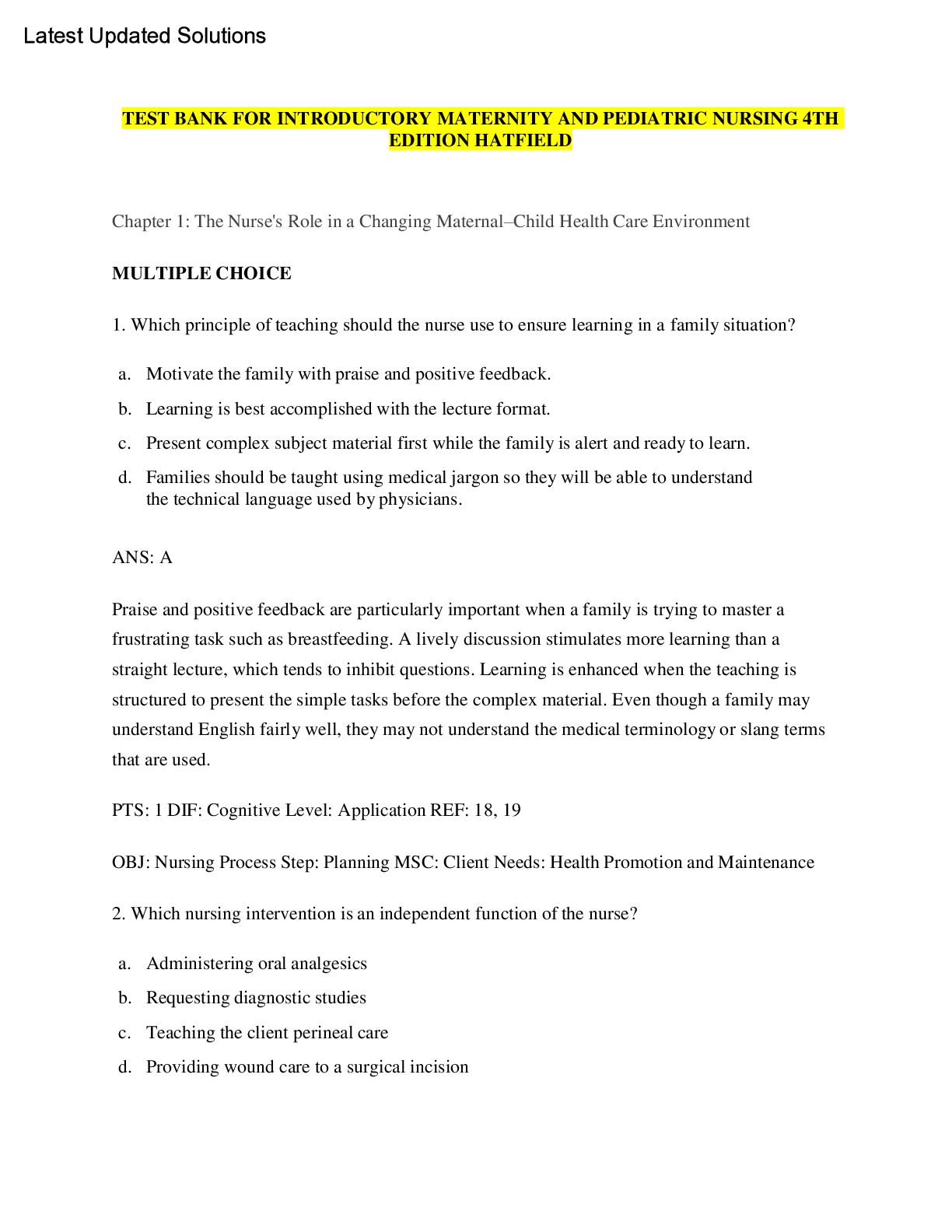
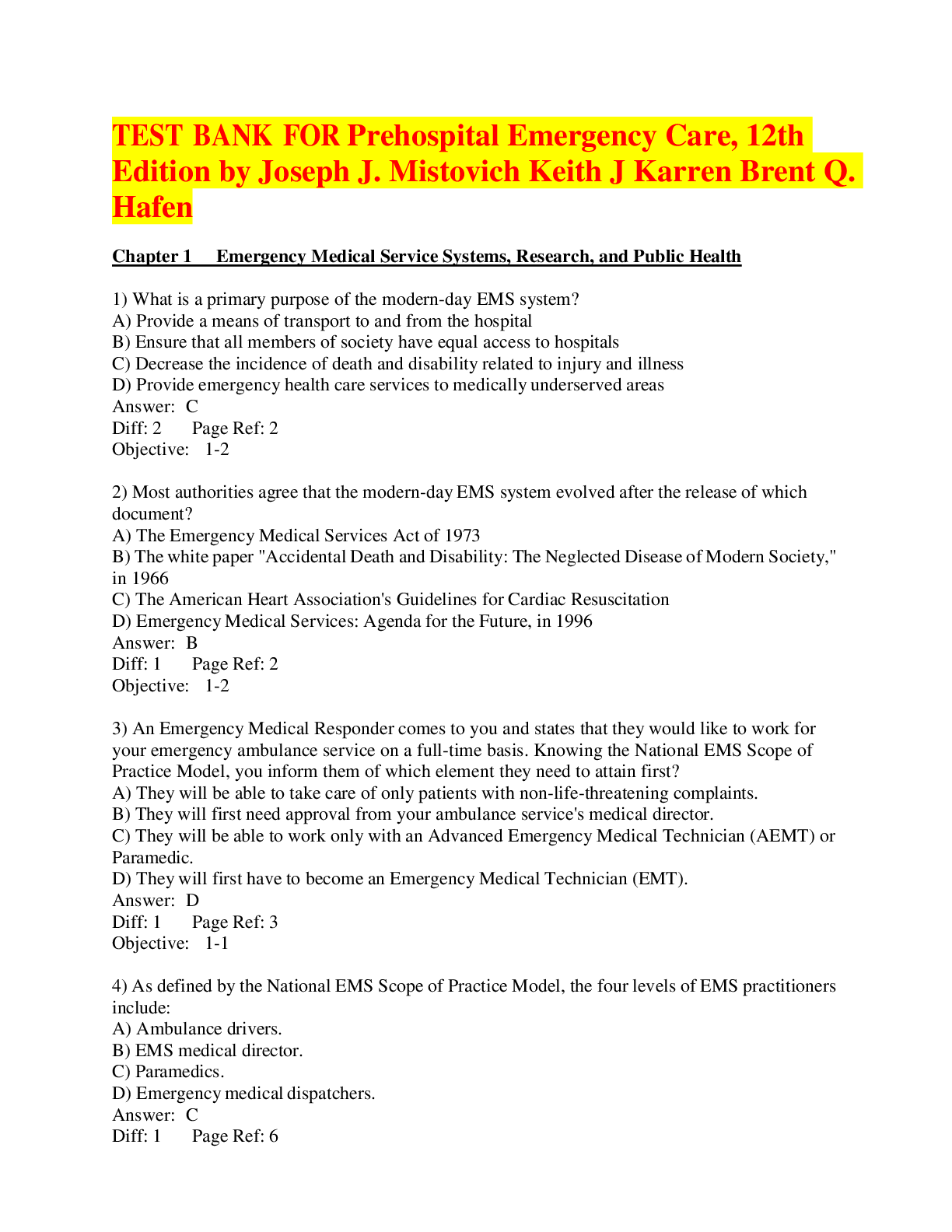


_compressed.png)
.png)
.png)


.png)

